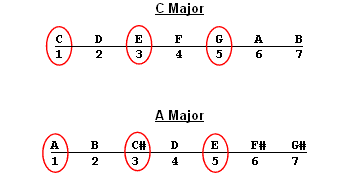Triads
All of the previous chord forms were built on triads. A triad is simply a chord containing three notes. The common chord forms that use more than three strings therefore have some of these notes repeated. What we want to do now is take a look at these triads across the neck in groups of three notes only, learning these are extremely useful.
Earlier on I talked about all chords and scales being based on the major scale and the notes in the major scale are numbered one to seven starting from the root. We can create any major triad by simply taking the 1st, 3rd and 5th scale degrees (intervals) from the major scale and using them to form a chord. The minor triad is the same thing but with the 3rd scale degree flattened.

As you can see it’s easy to find which notes belong to a chord if you already know the notes of the major scales. Memorizing all of the notes that belong to all of the scales and various chords is a great tool to have at your disposal but we are only going to concern ourselves with the interval relationships for the purpose of this course. The good thing about the guitar is the way we can move things around by shifting common patterns up and down without changing the shape of the pattern. Once you start learning the location of notes on the fretboard everything starts getting easier and all we need to do to find any triad is learn a few shapes and move them to any note we want.
Note: The distance between the 1st and 3rd is called a major third interval and the distance between the 1st and 5th is called a fifth (or a perfect fifth).


The diagrams above shows examples of how these intervals are arranged in the chords and simply repeated to make use of more than just three strings. What follows is a set of major and minor triad patterns using only three notes that you should make yourself familiar with.
Most of these patterns can be associated with, and found inside the common CAGED chord forms so take some time to look closely at them and find where they might fit into the chord shapes. For example you can see here how the E form chord contains three triad shapes.

Major Triads





Minor Triads





Learning these are vital to making your solos sound more musical. This is the key to creating solos that relate to the underlying chord changes. You know that a major chord is just the three notes 1, 3, 5 and a minor chord just flats the 3rd, once you get used to these patterns you will find it easy to think of chords as individual notes or patterns which you can use to create chord related licks and phrases that really inject life into your solos.
Leave a Reply